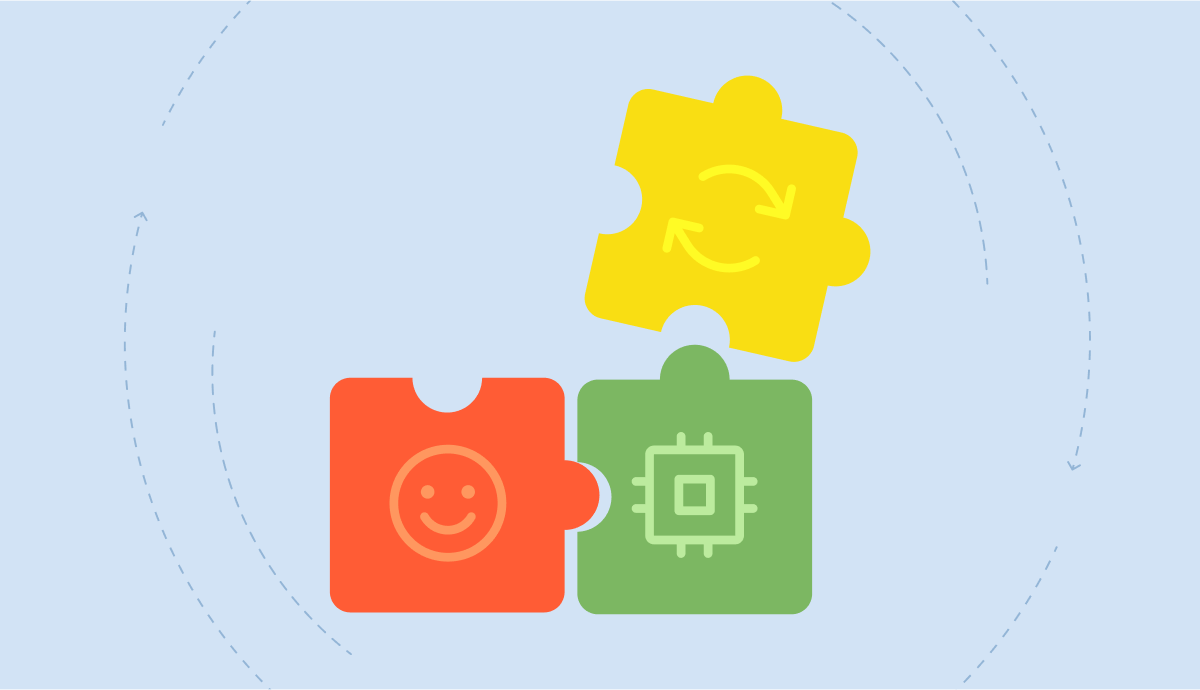
In order to achieve successful project integration management, you need the right people, process and technology in place. Many organizations struggle with these elements being executed in a holistic way to ultimately deliver great work, which can lead to unsuccessful projects.
Organizations often focus on one or two of those three areas at the expense of others. For example, an organization might have great processes but poor technology, or vice versa. Finding the right balance between people, process and technology in professional services is essential for a successful integration management strategy.
In this project integration management article, we will discuss the importance of the three components of people, process and technology, and how a critical balance among them can help improve the operational efficiency of professional services organizations.
What is Project Integration Management?
Project integration management is a strategy for optimizing successful project deliveries through a properly-coordinated balance of three key elements:
- People – Ensure qualified resources are available at the right time with the right skills to execute on necessary processes to complete projects successfully.
- Process – There are five core processes involved with project integration management that need to be well-designed and implemented as a foundation for a successful project delivery outcome.
- Technology – Technology needs to be properly selected and implemented in order to ensure that the project is successful through streamlined operational efficiency when managing process and resources.
Why is Project Integration Management Important for Project Success?
When recently speaking to a professional services leader of a medium-sized, but stagnating, consulting firm, she announced, “I need smart, motivated people, not technology.” When asked what their resource utilization was, there were a few answers:
- “Well, that is tricky for us because we are different…”
- “Roughly…” and then a range or swag was presented
- Capped off with, “I don’t know”
The focus of the discussion in this example turned back to creating a larger resource pool. In a resource-constrained economy, this has become an even larger issue. Ultimately, however, the people problem is a symptom and not a cause. While the need for smart, motivated people shouldn’t be diminished and very well may be true, it is not the whole story. The cause is around a lack of understanding of the universe of time that exists in all professional services organizations.
An analogy can be found in the children’s story, “The King, The Mouse and The Cheese,” where the king LOVES cheese, but so do the mice who infiltrate his castle. To get rid of the mice, the king’s wisemen suggest cats. When the mice are driven out, the king doesn’t like the cats either so the wisemen suggest dogs. The cats leave and now the king doesn’t like the dogs… so he brings in lions. Eventually, mice are brought back to get rid of the elephants that were brought in to eliminate the lions… how exhausting for the king and now he is back where he started—stuck with the mice again.
So, what does this have to do with solving complicated professional services problems?
Well, the moral of the story is exactly that. Problems are never simple and are certainly never resolved with only one solution. Coming back to professional services, an issue will seldom be fully fixed by JUST ramping up hiring, or JUST focusing on a standard multi-step process or a new technology. A balance is needed for successful integration management in project management.
In the end of the story, the king learns to live with the mice (who, incidentally, learned great table manners). For our consulting firm, we absolutely need to hire great people… but, what if we also brought in good technology to better understand how much resource capacity was needed and what types of people we needed? That data can unlock insight into the real problems we need to solve. And a disciplined process engrained in the culture of the organization paves the way for consistency and clear objectives.
In order to successfully integrate people, process, and technology in your project execution, you need to have a clear understanding of each one. Let’s take a closer look at them individually.
Integration Management Success Factor #1: People
The most important part of any project is the people involved. It’s people who understand the business needs better than any software or process, and it’s people who build and make use of processes and systems.
The only way for ideas to actually come to fruition is through people working together with a common goal in mind—and that’s what project integration management is all about: managing a project in a way that team members can achieve their intended goals on time and on budget. And teams can work collaboratively, producing their best work for customers.
Although technology can be helpful in streamlining some processes, it alone cannot replace the human element and establish a successful integration management implementation. You need strategic resource management techniques to make sure that you have an adequate number of resources available when they’re needed—and with the right skillsets to execute on necessary deliverables outlined by the project manager and customer.
It’s essential that everyone involved in a project shares the same vision and goal. Otherwise, there will be conflict that fuels project management challenges. Enter the need for clearly-outlined processes…
Integration Management Success Factor #2: Process
The process component is what sets the foundation for a successful project and defines how an organization and its project teams are going to manage activities and tasks to accomplish objectives. It is important to have a clear and concise process in place so that everyone knows what needs to be done, when it needs to be done, and how. And so that management can report on all projects in a consistent and meaningful way.
Without a good process, projects can quickly become chaotic and unorganized. And visibility into progress and key performance indicators becomes clouded.
There are five core project integration management processes to effectively plan and deliver projects at a services organization:
- Design a project charter to formalize the project’s mission and roles within it.
- Create a project management plan to keep track of time, money, and resources.
- Manage project knowledge and tasks by monitoring and controlling project progress based on the project management plan.
- Implement a change management process to make certain that any new features or requests don’t direct the schedule or budget off course.
- Bring the project to a close when it’s complete to move on to the next phase of development.
Processes are the glue that holds the project together, with these five steps of project integration management helping to avoid confusion when it comes to how people, information and resources are coordinated. For example, if your process flow doesn’t clearly explain how you’ll manage and document change requests or address other issues as they come up, then there’s no way for anyone who is new to the project to know what needs to be done or what steps have been taken already (or if anything has even been done at all).
When you involve people in process design decisions during the project planning phases, you can use their expertise to determine which processes will make your organization more efficient—and which ones may not be worth investing in. This is important because it’ll help you avoid spending money on a tool or system that won’t actually improve productivity or performance within your organization. The right technology tool will do just that, though—improve performance and empower people to deliver even greater work.
.png)
Integration Management Success Factor #3: Technology
The third and final success factor for project integration management is technology. Technology is one of the key enablers when it comes to delivering value on time and within budget at top-performing professional services organizations. Technology can help with the integration of people and process by providing project integration management tools that streamline processes, increase efficiency, reduce costs and eliminate manual effort.
Technology needs to be properly selected and implemented, however, in order to ensure that every project is successful when managing processes and resources. Purpose-built solutions like PSA (professional services automation) software support project integration management by providing project managers a pulse on service projects in real-time, as well as the ability to forecast future needs, trends and revenue. Project teams see an integrated view of the projects they’re working on and management has visibility into the health of the entire project portfolio.
People are also critical to integrating new technology into an existing information system because they add their knowledge and experience to help all stakeholders get what they want out of the new system (and that they don’t end up with something they don’t need). Working with the people in your organization to implement technology that works for them and their workflows will ensure faster adoption and more efficient use of the tools implemented.
When trying to balance people, process, and technology in your projects, it is important to keep in mind that each one is equally important. Without any one of them, the project and the performance of the organization as a whole will have a harder time meeting professional services KPI goals, let alone exceeding them to support growth and optimized efficiency. By understanding the challenges and importance of people, process and technology in tandem, you can set up your projects and your business for success.
Tips for Integrating People, Process and Technology for Project Success
The integration of people, process, and technology is critical for project success. Here are some tips for balancing the people, process and technology aspects of project integration management:
- Make sure team members understand their role in the project deliverables. Clear communication is essential for successful integration management.
- Create a detailed plan that covers all aspects of the project. This sets a roadmap so that everyone is on the same page and working towards the same goal.
- Use technology to your advantage. There are many project integration management tools available that can help you stay organized and on track.
- Be flexible and adaptable. Things will inevitably change during the course of a project and will need to be managed accordingly.
- Keep an eye on the big picture. It’s easy to get bogged down in the details, but it’s important to remember what the ultimate goal is.
Summary
The best approach to integration management is finding an optimal balance among the people, process, and technology within your services organization for improved project success. No single component can solve every problem, as they each serve a unique purpose toward achieving project goals and improving operational efficiency. Each of these elements are necessary for smooth and efficient completion of projects, but if any one of them is out of balance it can cause serious problems.
If you would like more information about how we can help your professional services organization make better use of its people, processes and technology, please get in touch with us today!
Frequently Asked Questions About Project Integration Management
What is the purpose of integration management?
Project integration management is a strategy for optimizing successful project deliveries through a properly-coordinated balance of three key elements:
1. People – Ensure qualified resources are available at the right time with the right skills to execute on necessary processes to complete projects successfully.
2. Process – There are five core processes involved with project integration management that need to be well-designed and implemented as a foundation for a successful project delivery outcome.
3. Technology – Technology needs to be properly selected and implemented in order to ensure that the project is successful through streamlined operational efficiency when managing process and resources.
What is an example of project integration management?
Project integration management helps to avoid confusion when it comes to how people, information and resources are coordinated. For example, if your process flow doesn’t clearly explain how you’ll manage and document change requests or address other issues as they come up, then there’s no way for anyone who is new to the project to know what needs to be done or what steps have been taken already (or if anything has even been done at all).
What are the 5 main processes involved in project integration management?
- Design a project charter to formalize the project’s mission and roles within it.
- Create a project management plan to keep track of time, money, and resources.
- Manage project knowledge and tasks by monitoring and controlling project progress based on the project management plan.
- Implement a change management process to make certain that any new features or requests don’t direct the schedule or budget off course.
- Bring the project to a close when it’s complete to move on to the next phase of development.
Why is project integration management important?
Project integration management helps organizations implement a holistic strategy to deliver great work, achieve project goals and improve operational efficiency through a balance of people, process and technology.
How do you succeed at project integration management?
Here are some tips for balancing people, process and technology for successful project integration management:
- Make sure team members understand their role in the project deliverables. Clear communication is essential for successful integration management.
- Create a detailed plan that covers all aspects of the project. This sets a roadmap so that everyone is on the same page and working towards the same goal.
- Use technology to your advantage. There are many project integration management tools available that can help you stay organized and on track.
- Be flexible and adaptable. Things will inevitably change during the course of a project. Be prepared to adjust your plans accordingly.
- Keep an eye on the big picture. It’s easy to get bogged down in the details, but it’s important to remember what the ultimate goal is.


.png)


